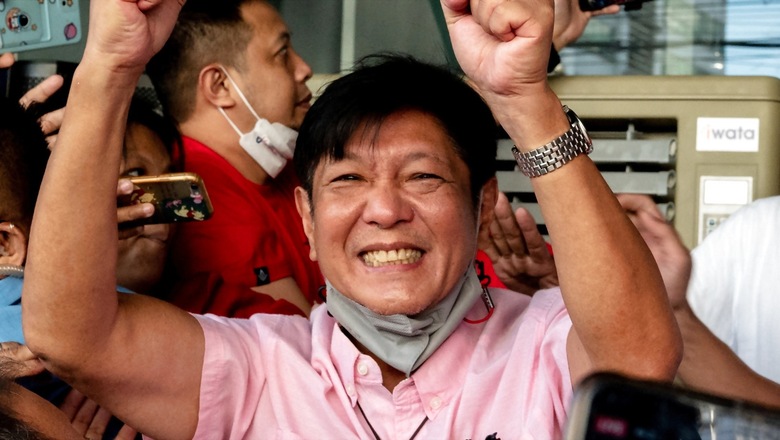
views
Despite the limited interaction between the two, Manila and New Delhi share numerous similarities. While the Philippines is a treaty ally of the United States under the Mutual Defense Treaty (1951), India is a close strategic partner of the country. Both are engaged in active territorial disputes with China and are committed to a rules-based system.
In May 2022, Ferdinand Marcos Jr (also known as Bongbong Marcos) won an outright majority in the presidential election in the Philippines. Son and name-bearer of former Philippines dictator Ferdinand Marcos, Marcos Jr paved the way for the country’s most infamous political dynasty’s shocking return to power.
It is no secret that Marcos Jr is a Beijing-friendly president, given the political alignment with Rodrigo Duterte, the outgoing President, who has been exceptionally vocal about his anti-Washington and pro-China stance. But Marcos Jr is a president who might play the game more strategically than his predecessor. Marcos is inspired by his father’s policy of maintaining a strong security alliance with Washington. Even though he is politically aligned with Duterte who sought to pivot away from the United States and towards China, Marcos will seek a balancing act.
Both, Manila and New Delhi find themselves in a precarious position amidst this Great Power Competition. The dichotomy of forging closer security relations with the US while maintaining good relations with China is restricting their foreign policy. The latter is necessary for Philippines’ economic development while the former is necessary to maintain its sovereignty and security vis-à-vis Beijing’s increasing assertion in the region.
The strategic partnership between the Philippines and India is of importance to both states. In a letter to then Indian Navy chief Admiral Karambir Singh in 2020, Philippines Navy Chief Giovanni Carlo J. Bacordo wrote, “We hope to expand this relationship as we seek better ways to make our seas safer and more secure for everyone.” This shows the Philippines’ willingness to work with India in the strategic and security domains. Prime Minister Narendra Modi had also expressed India’s regard for the Philippines as a “vital partner” in the Indo-Pacific region.
Relations between the two nations have been growing steadily. Indian cooperation with Southeast Asian states like the Philippines has been enhanced substantially as a result of the Act East Policy, Modi’s flagship programme. Former External Affairs Minister Sushma Swaraj had referred to the South China Sea as the “West Philippine Sea” in a joint statement with her Filipino counterpart in 2015. Prior to Duterte’s victory in 2016, India was inching closer to the Philippines in the strategic and security domain. In fact, India was very supportive of the Philippines following the UNCLOS Arbitral Tribunal’s decision that quashed China’s several claims in the South China Sea region. However, Duterte’s ceaseless effort to court Beijing, which even included abandoning the Tribunal verdict, made it difficult for India to find areas of strategic convergence with the island nation.
A change in leadership in Manila brings with it the opportunity for greater convergence between the two nations, India and the Philippines. It is predicted that a Philippines under Marcos Jr will continue engaging with China, in line with Duterte’s pro-China Policy, but at the same time will engage, and even bolster closer ties with the US to safeguard the Philippines’ sovereignty amidst an aggressively rising China. Thus, being in a similar situation in the Indo-Pacific security architecture will make India and the Philippines natural, strategic partners.
GREATER STRATEGIC CONVERGENCE
After Rodrigo Duterte was elected President of the Philippines in 2016, China saw an opportunity to draw the country away from Washington and into its sphere of influence. President Duterte’s open love for Beijing has significantly narrowed the areas of cooperation between nations in the Indo-Pacific region. However, it would be premature to assume Manila has completely closed its doors to newer, better opportunities.
It is expected that under Marcos Jr’s regime, the Philippines will strive for a peaceful and rules-based international system that can be a major avenue for their country’s growth and development. However, the challenge for Manila is finding a strategic partner that it can openly work with without upsetting either of the two nations, the US and China. For India, this is a golden opportunity to make up for lost time.
Both New Delhi and Manila, key players in the Indo-Pacific region, have a shared interest in the security of the region, especially in the maritime arena, which contains vital sea lines of communication (SLOCs) and a variety of traditional and non-traditional security challenges. Therefore, both India and the Philippines will benefit from closer relations, as they will be able to preserve a rules-based order amidst China’s growing aggressiveness.
India understands that cooperation should be based on mutual concerns and goals without ignoring any one party’s national interests. This is in line with Marcos Jr’s vision of an independent foreign policy that will provide Manila with great opportunities to expand its partnerships beyond its traditional neighbourhood.
Marcos Jr has expressed his willingness to enhance security dialogue with key countries as long as the Philippines’ national interests are respected. This strongly converges with the importance India places on strategic autonomy.
BOOSTING DEFENCE TIES
The Philippines has been a significant player in the South China Sea territorial disputes, particularly the Spratly Islands dispute, since the early 1990s. Chinese restrictions have prevented the Philippines from pursuing oil and gas developments and from fishing in the disputed waters.
Although the Philippines won on almost every count of the 2016 Permanent Court of Arbitration verdict, Chinese ships are still frequenting the Philippines’ exclusive economic zone without interruption. Filipino boats cannot easily access the traditional fishing grounds at Scarborough Shoal because of Chinese harassment. In spite of being a signatory of the treaty that established the court, China refuses to acknowledge its authority.
Satellite imagery has demonstrated China’s increased attempts to reclaim land in the South China Sea by enlarging islands or constructing new islands in recent years. China has piled sand on top of reefs, built ports, military installations and airstrips — especially in the Spratly Islands, where it has several outposts.
Marcos Jr referred to the ruling as “no longer available to us” because he knows that it is difficult to enforce it without China’s support. Rather, he seeks the presence of the state in disputed areas, a clear departure from Duterte’s policy of appeasement. According to him, “It is to show China that we are defending what we consider our territorial waters.”
Philippine officials praised India’s support for the country’s case against China in the South China Sea and urged a deeper relationship between the two countries. In January 2022, India signed a $374 million deal to export the BrahMos supersonic cruise missile to the Philippines. This would be the first Philippine weaponry with deterrent capability.
For the Philippines, the rationale behind the acquisition of BrahMos is to improve its coastal defence and keep a check on Chinese presence. At the same time, India is looking to boost its defence exports in order to strengthen its defence manufacturing and production.
With a foreign policy shift towards balancing and strategic autonomy expected under the Marcos Jr government, India and the Philippines are expected to have a higher level of cooperation, especially in the defence realm, positioning India as a reliable defence partner in the region. This will provide India the much-needed push in achieving the goal of $5 billion in defence exports by 2025.
A Win-Win?
With a change in power, it is expected that Manila’s China-friendly posture is likely to dial down a notch. Marcos Jr will adopt a foreign policy posture that is less sceptical of the United States, more apprehensive about China, and potentially more attracted to the thought of strengthening cooperation with like-minded countries, like India.
A growing bilateral partnership with India will allow Manila to better protect its national interests, promote territorial sovereignty and achieve a truly rules-based order in the region. For India, a logistics agreement, increased joint naval drills and an arms deal would provide a much-needed win in the region and allow power projection capabilities in distant seas. It will also create opportunities for India to export the BrahMos cruise missile to countries like Vietnam, Indonesia and make considerable inroads into the Southeast Asian defence market.
ALSO READ | China Spreads its Tentacles in Australia’s Backyard as the World Looks Away
Esha Banerji specialises in Defence and Strategic Studies at the Savitribai Phule Pune University. The views expressed in this article are those of the author and do not represent the stand of this publication.
Read all the Latest Opinions here
















Comments
0 comment